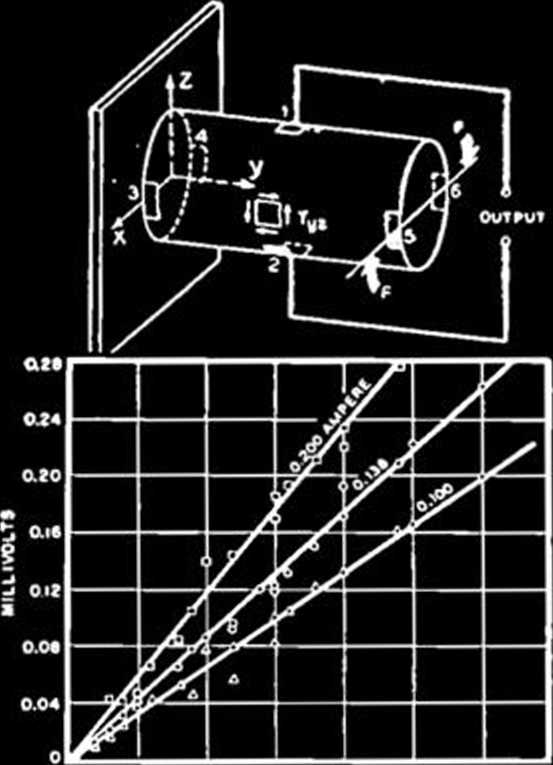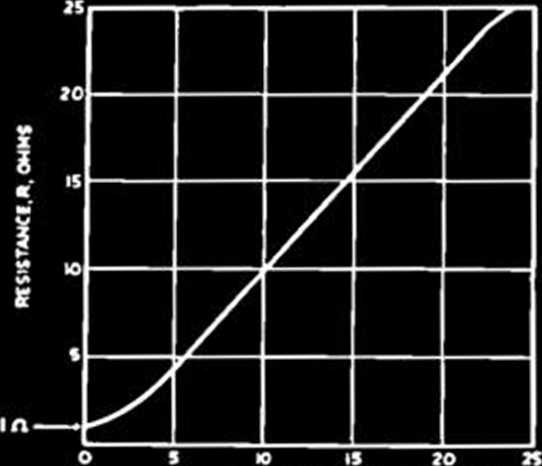7412533578

O 50 100 ISO too *30 300 330
TOPOuC II OMM-CCNTIHCTCRS
of the magnetic field and the current. As a typical example, if the current is *6 ampere and the field strength 10.000 gauss, the voltage may be around V* volt.
A commercial Hall Effect device is now on the market. It is manufactured by Ohio Semiconductors, Inc. and is known as the “Halltron HS-51," which is shown in the photograph of Fig. 6. The active part of this device is an intermetallic semiconductor known as indium antimonide. a materiał which has a very high mobility—much higher, in fact, than Silicon or gcrmanium.
Many possible applications can be envisioned for the “Halltron HS-51“ and similar devices. The most obvious, perha^s. ;s the measurcmcnt of magnetic field strength. For a constant current. the output voltage varics di-rectly with the strength of the magnetic field perpendicular to the slice of semiconductor materal. Other possible applications include a clip-on type ammeter. instantaneous power
SmunT ocsiSTANce
Fiq. 10. The torsional transducer. Graph Fiq. 12. Shown a borę is a photoqraph oi •hows calibrations at yarious biai currents. the torsional transducer described in text.
Gcrmanium appears to be useful up to 600°K.. Silicon to 100')°K.. and th^ -cw intermetallic semiconductor gallium arsenidc may e.xtcnd thc temperaturę rangę up to around 1400°K.
Semiconductor strain gauges may be designed to measure either displace-ment, as shown in Fig. 11. or torq..e, as indicated in Figs. 10 and 12. In the latter case, a cylinder cut from ger-manium is cemented to the torque member and six leads attached. When provided with appropriate biasing cur-rents, a direct-reading sensitive torque meter results.
Pressure gauges madę of semiconductor materials are extremely simple and reliable. The materials are sensi-tive to pressure. that is. their resist-ance changes as the pressure changes. Because of their stability and smali size, such gauges can be immersed in many different liquids and gases. and pressures measured by bringing two leads out of the Container.
Another desirable property is mc-chanical strength. In generał, semiconductor materials are relativcly rugged and will withstand fair amounts of bending and twist ing without becoming permanently deformed.
The Hall Effect
From our basie electricity we re-
Fiq. 11. Displacement qauqe constructed with qermanium crystals. Such qauqes aro up to two orders ol maqnitude moro sensi-tiro than common types that may be usod.
TO eoiOOE CiBCuiT
* 8ARS Of
URUANIUU

CiOC*

0<3»l.ACeMCNT
member that if a wire is carrying cur-rent while it is in a magnetic field, there will be a force acting on the wire. This is the basie operat ing principle of electric motors. If we were to explore the situation morę fully. we would find that the force actually acts on the free clectrons which are carrying the cur-rent in the wire and not on the wire it-self. The net effect is the same. though, sińce the clectrons are confined in the wire. Any sideways force on the elec-trons is transferred to the wire.
Because of this force. the clectrons in the wire are pushed over to one side, leading to an exccss of clectrons on that side and on the other side a defi-ciency. We might then expect that a voltage would exist between the sides of the wire. This is exactly what does happen. except that in good conductors the voltage is very smali and hard to detect. This is known as the “Hall Ef-fect" and the voltage is called the “Hall Effect voltage.“
The Hall Effect is a very useful tool in studying semiconductors. because in such materials the effect is appreciable an'-. the voltages produced can be measured readily. In a semiconductor. the current may not consist entirely of a flow of clectrons but may also include the mocement of "holes” or spaces where an electron is absent. As may be expected. the magnitude of the Hall Effect depends on how easily these electrons and “holes," usually called charge carriers. move around in the materiał. This property has bcen termed “mobility." Greater mobility preduces greater Hall Effect vo!tage.
Fig. 7 shows the results of the Hall Effect. Here we have a slice of semiconductor materiał with current flow-ing through it. A magnetic field is per-pendicular to the slice. When these two conditions exist. a voltage will ap-pear across the sides of the slice. its magnitude proportional to the product

Amm KACNCTIC tnOUCTtOH b. KILOCAUSS
Flq. 13. Reslstance ol typical MS-41 Maq-netoresistor lor Tarious magnolie lields.
Fiq. 14. Neutron detector lormed by a thln slice of qermanium coated with uranium layer.
meter, d.c.-to-a.c. converter, and per-haps in computcrs for analogue sum-mation and multiplication.
Westinghouse has also announced the development of Hall generators using both indium antimonide and indium arsenide. Voltages of l/» volt with a magnetic field strength of 5000 (Continued on page 148)
52
ELECTRONICS WORLD
Wyszukiwarka
Podobne podstrony:
skanuj0006 2 Preparaty Pramolan, Insidon -doustnie 50-100 mg dziennie, maksymalnie 300 mg dziennie w
winplot2 — w(liczbapróbek) 50 100 150 200 250 300 350 400 450 500 550 600 650 700 750 800 850 900 li
38471 winplot2 — w(liczbapróbek) 50 100 150 200 250 300 350 400 450 500 550 600 650 700 750 800 850
OSCYLATOR HARMONICZNY m - masa odważnika przyczepionego do oscylatora m = 50, 100,150, 200, 250, 300
Photo00255 500 g cały 1 kg 166. Melon 330 g 17 o g 767. Mandarynki 50 g 100 g 168, Nektarynki 150 g
Plan of Persepolis Plan o f Scalę of Feet 100 50 o ^ 100 * 200 &
140 S. 0 s. 15 w. 100 Z. 30 w. 100 i 50 w. 100 2. 75 w. 100 ź. 90 w. 100 ź. bez klastra 3
100 200 amin 20 = 300 400 50$ 600 1.03 m/s mDistance (m) O 20 40 60 80 100 120 140 J.60 « Całculated
LLIAJlb (B - 17), cTp. 7. BaM noTpeOyercfl np«xa N?32/2 (100% ujepciM) b 3 cno*emto • 300 r *tepnoH,
47a (8) Model 3 Wielkość: Ok. 38 x 39 cm Materiał: 100 g białej włóczki bawełnianej (dt. 330 m/50 g)
^--^Miejsce zwarcia [km] 10 50 100 200 300 Rodzaj zwarcia L1 -z Ziemią Baza 1 Baza
CCI20121130�02 2012-11-30 GRANICE SŁYSZALNOŚCI 20 Hz-20000 Hz 20 50 100 200 500 1000 2000 5000 10000
Zależność wytrzymałości na ściskanie od zawartości cementu przy różnej yQ pianobetonu m 0 50 100 tOO
Inżynieria środowiska 3. c02t = 12,5 % Rozwiązanie BZTred = BZTp- BZTk BZT„a = 330- 30= 300 mg
100% 10 20 30 prędkość 40 50 o Prawdopodobieństwo obrażeń śmiertelnych
więcej podobnych podstron